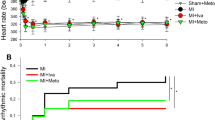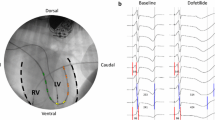Summary
Effects of bepridil, an antiarrhythmic and antianginal drug, on intraventricular conduction in acutely ischaemic and infarcted myocardium were examined in anaesthetized dogs, and compared with those of lidocaine.
Bepridil at doses of 2 and 5 mg/kg markedly prolonged the conduction time of a premature excitation induced by a ventricular stimulation in the infarcted zone. The effect of bepridil was dependent on a coupling time of the stimulation. Bepridil showed a marked effect at a coupling time of 150 ms, while it showed no significant effect at a prolonged coupling time of 1 s. In other words, the effect of bepridil was interval-dependent. Lidocaine showed a similar interval-dependent effect, but the effect of lidocaine at a longer coupling time was less than that of bepridil. The premature stimulation produced severely delayed conduction which resulted in reentrant beats. Bepridil blocked these conductions, thereby preventing reentrant beats. In contrast to the depressant effect of bepridil in the infarcted myocardium, bepridil prevented the prolongation of conduction time during acute ischaemia. The alternation of the ST-T complex during acute ischaemia which is also an important arrhythmogenic factor was also attenuated by bepridil. Contrary to bepridil, lidocaine significantly enhanced the conduction delay and the alternation in the ST-T complex.
In conclusion, bepridil as well as lidocaine showed an interval-dependent depression of the conduction in the infarcted zone of the heart, whereas during acute ischaemia bepridil in contrast to lidocaine attenuated the conduction delay and ST-T alternans.
Similar content being viewed by others
References
Anno T, Furuta T, Itch M, Kodama I, Toyama I, Yamada K (1984a) Electromechanical effects of bepridil on rabbit isolated hearts. Br J Pharmacol 81:41–47
Anno T, Furuta T, Itoh M, Kodama I, Toyama J, Yamada K (1984b) Effects of bepridil on the electrophysiological properties of guinea-pig ventricular muscles. Br J Pharmacol 81:589–597
Cardinal R, Janse MJ, van Eeden I, Werner G, D'Alnoncourt N, Durrer D (1981) The effects of lidocaine on intracellular and extracellular potential, activation, and ventricular arrhythmias during acute regional ischemia in the isolated porcine heart. Circ Res 49:792–806
Chen C-M, Gettes, LS, Katzung BG (1975) Effect of lidocaine and quinidine on steady-state characteristics and recovery kinetics of (dV/dt)max in guinea pig ventricular myocardium. Circ Res 37:20–29
Cosnier D, Duchene-Marullaz P, Rispat G, Streichenberger G (1977) Cardiovascular pharmacology of bepridil (1,3-isobutoxy-2-(benzylphenyl)aminopropyl pyrrolidine hydrochloride), a new potential antianginal compound. Arch Int Pharmacodyn Ther 255:133–151
Courtney KR (1980) Interval-dependent effects of small antiarrhythmic drugs on excitability of guinea-pig myocardium. J Mol Cell Cardiol 12:1273–1286
El-Sherif N, Scherlag BJ, Lazzara R (1975) Electrode catheter recording during malignant ventricular arrhythmias following experimental acute myocardial ischemia. Evidence for re-entry due to conduction delay and block in ischemic myocardium. Circulation 51:1003–1014
Harris AS (1950) Delayed development of ventricular ectopic rhythms following experimental coronary occlusion. Circulation 1:1318–1324
Hashimoto H, Nakashima M (1981) Effects of calcium antagonists on the alternation of the ST-T complex and associated conduction abnormalities during coronary occlusion in dogs. Br J Pharmacol 74:371–380
Hashimoto H, Asano M, Takiguchi Y, Nakashima M (1982a) Effects of Ca-antagonists on the ST-T alternans, myocardial oxygen tension and myocardial pH during coronary occlusion in dogs. Jpn Heart J 23 (Suppl):434–437
Hashimoto K, Satoh H, Shibuya T, Imai S (1982b) Canine-effective plasma concentrations of antiarrhythmic drugs on the two-stage coronary ligation arrhythmia. J Pharmacol Exp Ther 223:801–810
Hashimoto H, Asano M, Nakashima M (1984a) Potentiating effects of a ventricular premature beat on the alternation of the ST-T complex of the epicardial electrograms and the incidence of ventricular arrhythmias during acute coronary occlusion in dogs. J Electrocardiol 17:289–301
Hashimoto H, Hayashi T, Oguro K, Nakashima M (1984b) Effects of antiarrhythmic drugs on the ST-T alternans and ventricular arrhythmias during acute coronary occlusion in dogs. Jpn J Pharmacol 38 (Suppl):265
Hashimoto H, Asano M, Takiguchi Y, Katoh H, Nakashima M (1985) Effects of nicardipine, a dihydropyridine calcium antagonist, on regional myocardial blood flow, myocardial oxygen tension and electrical abnormalities during acute coronary artery occlusion in dogs. J Cardiovasc Pharmacol 7:613–621
Hashimoto H, Nagashima S, Ozaki T, Matsuno H, Nakashima M (1989) Effects of antiarrhythmic drugs on intraventricular conduction in canine myocardial infarction. In: Toyama J (ed) Current topics in antiarrhythmic agents. Excerpta Medica, Tokyo, pp 156–159
Hauswirth O, Singh BN (1979) Ionic mechanisms in heart muscle in relation to the genesis and the pharmacological control of cardiac arrhythmias. Pharmacol Rev 30:5–63
Hondeghem LM, Katzung BG (1977) Time- and voltage-dependent interactions of antiarrhythmic drugs with cardiac sodium channels. Biochim Biophys Acta 472:373–398
Janse MJ, van Capelle FLJ, Morsink H, Kléber AG, Wilms-Schopman F, Cardinal R, D'Alnoncourt CN, Durrer D (1980) Flow of “injury” current and patterns of excitation during early ventricular arrhythmias in acute regional myocardial ischemia in isolated porcine and canine hearts. Evidence for two different arrhythmogenic mechanisms. Circ Res 47:151–165
Janse MJU, Kléber AG (1981) Electrophysiological changes and ventricular arrhythmias in early phase of regional myocardial ischemia. Circ Res 49:1069–1081
Jestadt R, Sandritter HW (1959) Erfahrungen mit der TTC (Triphenyltetrazoliumchlorid) Reaktion für die pathologisch-anatomische Diagnose des frischen Herzinfarktes. Kreislaufforschung 48:802–81
Jolly SR, Lucchesi BR (1983) Effect of BW755C in an occlusion-reperfusion model of ischemic myocardial injury. Am Heart J 106:8–13
Kane KA, Winslow E (1980) Antidysrhythmic and electrophysiological effects of a new antianginal agent, bepridil. J Cardiovasc Pharmacol 2:193–203
Kaplanski E, Ogawa S, Blake W, Dreifus L (1979) Two periods of early ventricular arrhythmias in the acute myocardial infarction model. Circulation 60:397–403
Kataoka K, Nakano H, Yoshimura R (1979) Clinical and experimental studies in electrical alternans of ST segment and T wave in variant form of angina pectoris. Respir Circ 27:767–776
Kléber AG, Janse MJ, van Capelle FJL, Durrer D (1978) Mechanism and time course of S-T and T-Q segment changes during acute regional myocardial ischemia in the pig heart determined by extracellular and intracellular recordings. Circ Res 42:603–613
Kleinfeld M, Rozanski JJ (1977) Alternans of the ST segment in Prinzmetal's angina. Circulation 55:574–577
Labrid C, Leinot M, Beaughard M, Basiez M, Duchene-Marullaz P (1981) Comparative antidysrhythmic profiles of bepridil, amiodarone and disopyramide in the guinea-pig and dog. Arch Int Pharmacodyn Ther 249:87–97
Lynch JJ, DiCarlo LA, Montgomery DG, Lucchesi BR (1986) Electrophysiological effects of bepridil in normal and infarcted canine myocardium. J Cardiovasc Pharmacol 8:957–966
Marshall RJ, Muir AW (19812) The beneficial actions of bepridil in acute myocardial infarction in anaesthetized dogs. Br J Pharmacol 73:471–479
Michelin MT, Cheucle M, Duchene-Marullaz P (1977) Comparative influence of bepridil, dipyridamole and propranolol on cardiac activity and coronary venous blood flow in the anaesthetized dog. Therapie 32:485–490
Nishimoto M, Hashimoto H, Ozaki T, Nagashima S, Nakashima M (1990) Effect of antidepressants on the intraventricular conduction and the incidence of arrhythmias induced by programmed ventricular stimulation in the dog heart after myocardial infarction. Naunyn-Schmiedeberg's Arch Pharmacol 341:240–245
Russel DC, Smith HJ, Oliver F (1979) Transmembrane potential changes and ventricular fibrillation during repetitive myocardial ischaemia in the dog. Br Heart J 42:88–96
nSteenberg ML, Buckley JP, Jandhyla BS (1978) Effects of bepridil ([3-isobutoxy 2 (benzylphenyl)amino]propyl pyrrolidine HCl) on coronary and systemic hemodynamics of anesthetized dogs. Pharmacologist 20, 173P
Vogel S, Crampton R, Sperelakis N (1979) Blockade of myocardial slow channels by bepridil (GERM-1978). J Pharmacol Exp Ther 210:378–385
Winslow E, Kane A (1981) Supraventricular antidysrhythmic and electrophysiological effects of bepridil, a new antianginal agent. J Cardiovasc Pharmacol 3:665–667
Yatani A, Brown AM, Schwartz A (1986) Bepridil block of cardiac calcium and sodium channels. J Pharmacol Exp Ther 237:9–17
Author information
Authors and Affiliations
Additional information
Send offprint requests to H. Hashimoto at the above address
Rights and permissions
About this article
Cite this article
Hashimoto, H., Satoh, N. & Nakashima, M. Effects of bepridil and lidocaine on the intravenctricular conduction in acutely ischaemic and infarcted canine myocardium. Naunyn-Schmiedeberg's Arch Pharmacol 342, 683–690 (1990). https://doi.org/10.1007/BF00175713
Received:
Accepted:
Issue Date:
DOI: https://doi.org/10.1007/BF00175713




